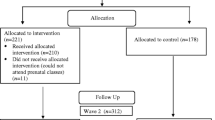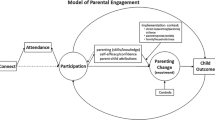Abstract
Analyses of program engagement can provide critical insight into how program involvement leads to outcomes. This study examines the relation between participant engagement and program outcomes in Family Foundations (FF), a universal preventive intervention designed to help couples manage the transition to parenthood by improving coparenting relationship quality. Previous intent-to-treat outcome analyses from a randomized trial indicate FF improves parental adjustment, interparental relationships, and parenting. Analyses for the current study use the same sample, and yield statistically reliable relations between participant engagement and interparental relationships but not parental adjustment or parenting. Discussion considers implications for FF and the difficulties researchers face when examining the relation between engagement and outcomes in preventive interventions.
Similar content being viewed by others
References
Abidin, R. R. (1997). Parenting stress index: A measure of the parent-child system. In C. P. Zalaquett & R. J. Wood (Eds.), Evaluating stress: A book of resources (pp. 277–291). Lanham, MD: Scarecrow Education.
Abidin, R. R., & Brunner, J. F. (1995). Development of a parenting alliance inventory. Journal of Clinical Child Psychology, 24(1), 31–40.
Ahlborg, T., & Strandmark, M. (2006). Factors influencing the quality of intimate relationships six months after delivery—First-time parents’ own view and coping strategies. Journal of Psychosomatic Obstetrics & Gynecology, 27(3), 163–172.
Arnold, D. S., O’ Leary, S. G., Wolff, L. S., & Acker, M. M. (1993). The Parenting Scale: A measure of dysfunctional parenting in discipline situations. Psychological Assessment, 5, 137–144.
Bendig, A. W. (1956). The development of a short form of the Manifest Anxiety Scale. Journal of Consulting Psychology, 20, 384.
Braiker, H., & Kelley, H. H. (1979). Conflict in the development of close relationships. In R. L. Burgess & T. L. Huston (Eds.), Social exchange in developing relationships (pp. 135–168). New York: Academic Press.
Brown, L. D., Feinberg, M. E., & Kan, M. L. (2011). Predicting engagement in a transition to parenthood program for couples. Evaluation and Program Planning, 35, 1–8.
Burstein, M., Ginsburg, G. S., & Tein, J.-Y. (2010). Parental anxiety and child symptomatology: An examination of additive and interactive effects of parent psychopathology. Journal of Abnormal Child Psychology, 38(7), 897–909.
Charlebois, P., Brendgen, M., Vitaro, F., Normandeau, S., & Boudreau, J. F. (2004). Examining dosage effects on prevention outcomes: Results from a multi-modal longitudinal preventive intervention for young disruptive boys. Journal of School Psychology, 42, 201–220.
Cordova, A. D. (2001) Teamwork and the transition to parenthood. Dissertation Abstracts International: Section B: The Sciences and Engineering 61(9-B), 5052.
Crowne, D. P., & Marlow, D. (1964). The approval motive. New York: John Wiley.
D’Onofrio, B. M., Turkheimer, E. N., Eaves, L. J., Corey, L. A., Berg, K., Solaas, M. H., et al. (2003). The role of the children of twins design in elucidating causal relations between parent characteristics and child outcomes. Journal of Child Psychology and Psychiatry, 44(8), 1130–1144.
Feinberg, M. E. (2002). Coparenting and the transition to parenthood: A framework for prevention. Clinical Child and Family Psychology Review, 5(3), 173–195.
Feinberg, M. E. (2003). The internal structure and ecological context of coparenting: A framework for research and intervention. Parenting: Science & Practice, 3(2), 95.
Feinberg, M. E., Jones, D. E., Kan, M. L., & Goslin, M. C. (2010). Effects of Family Foundations on parents and children: 3.5 years after baseline. Journal of Family Psychology, 24, 532–542.
Feinberg, M. E., & Kan, M. L. (2008). Establishing Family Foundations: Intervention effects on coparenting, parent/infant well-being, and parent–child relations. Journal of Family Psychology, 22(2), 253–263.
Feinberg, M. E., Kan, M. L., & Goslin, M. C. (2009). Enhancing coparenting, parenting, and child self-regulation: Effects of Family Foundations one year after birth. Prevention Science, 10, 276–285.
Felner, R. D., Brand, S., Mulhall, K. E., Counter, B., et al. (1994). The parenting partnership: The evaluation of a human service/corporate workplace collaboration for the prevention of substance abuse and mental health problems, and the promotion of family and work adjustment. The Journal of Primary Prevention, 15(2), 123–146.
Frank, S. J., Olmstead, C. L., Wagner, A. E., & Laub, C. C. (1991). Child illness, the parenting alliance, and parenting stress. Journal of Pediatric Psychology, 16(3), 361–371.
Gibaud-Wasston, A., & Wandersman, L. P. (1978). Development and utility of the parenting sense of competence scale. Paper presented at the American Psychological Association.
Gutman, L. M., McLoyd, V. C., & Tokoyawa, T. (2005). Financial strain, neighborhood stress, parenting behaviors, and adolescent adjustment in urban African American families. Journal of Research on Adolescence, 15(4), 425–449.
Halfon, N., & Hochstein, M. (2002). Life course health development: An integrated framework for developing health, policy, and research. Milbank Quarterly, 80, 433–479.
Hansen, D. J., & Warner, J. E. (1994). Treatment adherence of maltreating families: A survey of professionals regarding prevalence and enhancement strategies. Journal of Family Violence, 9, 1–19.
Herman, D. B., & Mandiberg, J. M. (2010). Critical time intervention: Model description and implications for the significance of timing in social work interventions. Research on Social Work Practice, 20, 502–508.
Kazdin, A. E., Mazurick, J. L., & Siegel, T. C. (1994). Treatment outcome among children with externalizing disorder who terminate prematurely versus those who complete psychotherapy. Journal of the American Academy of Child and Adolescent Psychiatry, 33(4), 549–557.
Kessler, R. C., Turner, B., & House, J. S. (1988). Effects of unemployment on health in a community survey: Main, modifying, and mediating effects. Journal of Social Issues, 44(4), 69–86.
Kosterman, R., Hawkins, J. D., Haggerty, K. P., Spoth, R., & Redmond, C. (2001). Preparing for the drug free years: Session-specific effects of a universal parent-training intervention with rural families. Journal of Drug Education, 31(1), 47–68.
Margolin, G., Gordis, E. B., & John, R. S. (2001). Coparenting: A link between marital conflict and parenting in two parent families. Journal of Family Psychology, 15(1), 3–21.
McHale, J. P. (1997). Overt and covert coparenting processes in the family. Family Process, 36(2), 183–201.
Norton, R. (1983). Measuring marital quality: A critical look at the dependent variable. Journal of Marriage and the Family, 45, 141–151.
Radloff, L. S. (1977). The CES-D Scale: A self-report depression scale for research in the general population. Applied Psychological Measurement, 1, 385–401.
Reid, M. J., Webster-Stratton, C., & Baydar, N. (2004). Halting the development of conduct problems in Head Start children: The effects of parent training. Journal of Clinical Child and Adolescent Psychology, 33, 279–291.
Reyno, S. M., & McGrath, P. J. (2006). Predictors of parent training efficacy for child externalizing behavior problems—Meta-analytic review. Journal of Child Psychology and Psychiatry, 47, 99–111.
Schafer, J. L. (1997). Analysis of incomplete multivariate data. London: Chapman & Hall.
Sinharay, S., Stern, H. S., & Russell, D. (2001). The use of multiple imputation for the analysis of missing data. Psychological Methods, 6, 317–329.
Snell-Johns, J., Mendez, J. L., & Smith, B. H. (2004). Evidence-based solutions for overcoming access barriers, decreasing attrition, and promoting change with underserved families. Journal of Family Psychology, 18, 19–35.
Spoth, R. L., & Redmond, C. (1996). A theory-based parent competency model incorporating intervention attendance effects. Family Relations, 45, 139–147.
Spoth, R. L., Redmond, C., Haggerty, K., & Ward, T. (1995). A controlled parenting skills outcome study examining individual difference and attendance effects. Journal of Marriage and Family, 57, 449–464.
Staudt, M. (2007). Treatment engagement with caregivers of at-risk children: Gaps in research and conceptualization. Journal of Child and Family Studies, 16, 183–196.
Taylor, J. A. (1953). A personality scale of manifest anxiety. Journal of Abnormal and Social Psychology, 48, 285–290.
Van Egeren, L. A. (2003). Prebirth predictors of coparenting experiences in early infancy. Infant Mental Health Journal, 24(3), 278–295.
Waylen, A., & Stewart-Brown, S. (2010). Factors influencing parenting in early childhood: A prospective longitudinal study focusing on change. Child Care, Health & Development, 36(2), 198–207.
Webster-Stratton, C., Reid, M. J., & Hammond, M. (2004). Treating children with early onset conduct problems: Intervention outcomes for parent, child, and teacher training. Journal of Clinical Child and Adolescent Psychology, 33, 105–124.
Acknowledgments
We are grateful to the families who participated in this study. We appreciate the assistance of Karen Newell, Sherry Turchetta, Carole Brtalik, Sharolyn Ivory, David White, Ned Hoffner, Dan Marrow, Ellen McGowan, and Kathryn Siembieda in implementing the program. We thank Jesse Boring, Carmen Hamilton, Richard Puddy, Carolyn Ransford, and Samuel Sturgeon for their assistance in conducting this study. George Howe, Mark Greenberg, James McHale, Pamela Cole, and Doug Teti provided thoughtful advice and support. This study was funded by grants from the National Institute of Child Health and Development (1 K23 HD042575) and the National Institute of Mental Health (R21 MH064125-01), Mark E. Feinberg, principal investigator.
Author information
Authors and Affiliations
Corresponding author
Rights and permissions
About this article
Cite this article
Brown, L.D., Goslin, M.C. & Feinberg, M.E. Relating Engagement to Outcomes in Prevention: The Case of a Parenting Program for Couples. Am J Community Psychol 50, 17–25 (2012). https://doi.org/10.1007/s10464-011-9467-5
Published:
Issue Date:
DOI: https://doi.org/10.1007/s10464-011-9467-5




